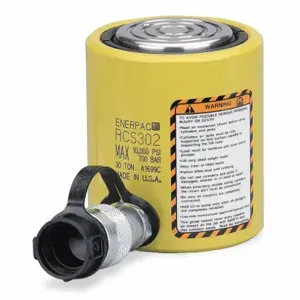Enerpac RCS-302 low-height hydraulic cylinder is used in construction, manufacturing, maintenance and repair tasks for lifting, pushing, pulling and positioning heavy loads. It is attached to a hydraulic pump to lift heavy loads with minimal effort.
Features:
- Enerpac RCS-302 low-height hydraulic cylinder offers baked enamel finish, enhancing its aesthetic appeal and providing excellent corrosion resistance.
- This cylinder is equipped with a plunger wiper to reduce contamination and offer a longer lifespan effectively.
- It features a grooved plunger end with threaded holes for convenient mounting of tilt saddles.
- This cylinder features plated steel plungers to withstand abrasion.
Compatible Accessories:
- Enerpac P-802 Hydraulic Pump: It features glass filled nylon reservoir for dimensional stability and increased wear resistance. It attaches to this cylinder for easily lifting heavy loads.
- Enerpac GA2 Gauge Adapter: This gauge adapter is used to easily attach pressure gauges to the brand's RCS302 cylinder for preciely taking pressure readings.
Frequently Asked Questions:
Q. What comes with this low-height hydraulic cylinder?
A. All models of this hydraulic cylinder come included with a dust cap and CR-400 coupler.
Q. What is the rated pressure of Enerpac RCS-302 single-acting piston cylinder?
A. 10000 PSI
Q. What are the maintenance factors of this Enerpac RCS-302 low-height hydraulic cylinder?
A. It is important to perform routine inspections of this low-height hydraulic cylinder to check for any damage or signs of wear. Any accumulated dirt or debris should be removed to prevent potential performance issues. Additionally, Enerpac suggests that the hydraulic oil in the cylinder should be changed after 2000 hours of use or every 12 months, whichever comes first.
Q. How can I install this Enerpac RCS-302 low-height hydraulic cylinder?
A. It can be installed by attaching it to a hydraulic pump, which will pressurise the hydraulic fluid in the cylinder, resulting in the piston moving and generating force. The cylinder can then be attached to a load or a supporting structure by using the plunger and base mounting holes provided on the cylinder.
Q. How do I maintain this Enerpac RCS-302 low-height hydraulic cylinder?
A.
- Perform routine inspections on the hydraulic cylinder to check for any damage or signs of wear.
- Remove any accumulated dirt or debris from the cylinder to prevent potential performance issues.
- Follow Enerpac's recommendation to change the hydraulic oil in the cylinder after 2000 hours of use or every 12 months, whichever comes first.
Q. How can I install this Enerpac RCS-302 low-height hydraulic cylinder?
A.
- Attach the hydraulic cylinder to a hydraulic pump.
- The hydraulic pump will pressurise the hydraulic fluid within the cylinder.
- The pressurised hydraulic fluid causes the piston in the cylinder to move, generating force.
- Use the plunger and base mounting holes provided on the cylinder to attach it securely to a load or a supporting structure.
Q. What factors should be considered while choosing a hydraulic cylinder?
A.
- Determine the maximum load the cylinder needs to handle.
- Consider the required range of movement for the application.
- Ensure the cylinder can handle the required pressure levels.
- Evaluate the available space and the type of mounting required (flange, clevis, etc.).
- Assess the desired speed of operation for the application.
- Choose the appropriate seal material for the specific operating conditions.
Q. What is the rated pressure of this Enerpac RCS-302 single-acting piston cylinder?
A. It has a maximum working pressure of 10000 psi.







